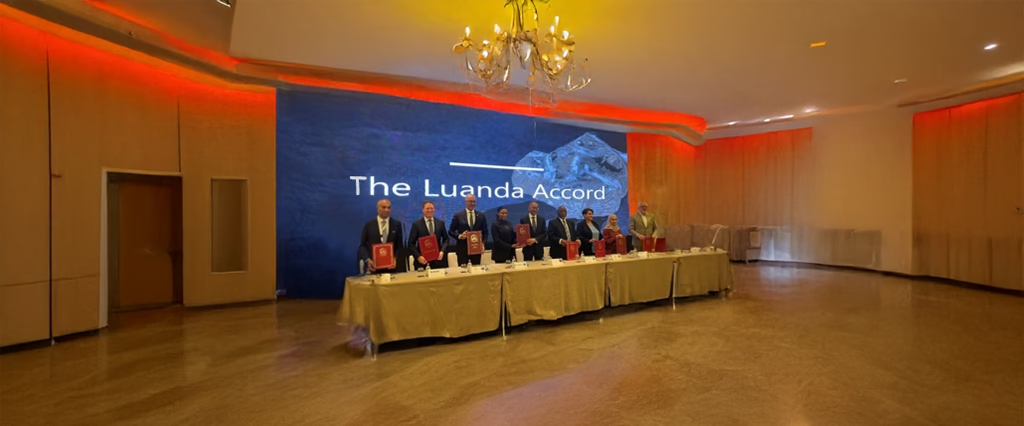A New Dawn for Diamonds: The Luanda Accord Forges a Unified Front to Revitalize the Natural Gem Industry
In the glittering, high-stakes world of natural diamonds, a seismic shift is underway. For years, the industry has navigated a turbulent landscape, buffeted by the rise of lab-grown alternatives, shifting consumer values, and geopolitical tremors that have shaken its very foundations. Now, in a powerful display of unity and strategic foresight, a new chapter is being written. According to Luanda Accord, the Natural Diamond Council (NDC), the primary marketing arm for the industry, is poised for a monumental resurgence, thanks to a landmark agreement forged in the heart of one of Africa’s key diamond-producing nations.
This historic pact, christened the Luanda Accord, was signed on June 18th in Angola’s bustling capital. It represents far more than a simple funding commitment; it is a declaration of collective will, a strategic alliance designed to reclaim the narrative and secure the future of natural diamonds for a new generation. The agreement brings together an unprecedented coalition of six major diamond-producing African nations, a leading global cutting center, and two of the world’s most influential gem trading hubs. This is not just a financial injection; it is the formation of a global phalanx dedicated to one singular mission: to passionately and effectively promote the enduring allure, rarity, and legacy of natural diamonds.

The Architects of a Diamond Renaissance
The list of signatories to the Luanda Accord reads like a “who’s who” of the global diamond pipeline. The national powerhouses of Botswana, Angola, Sierra Leone, Namibia, South Africa, and the Democratic Republic of Congo have all pledged their support. These are not just names on a map; they are the very source of the world’s most coveted gems, nations whose economies and communities are intrinsically linked to the responsible mining of diamonds. Their commitment signifies a grassroots, source-level investment in the future of their most precious natural resource.
Joining them are critical industry organizations that form the connective tissue of the global trade. The Antwerp World Diamond Centre (AWDC), the historic heart of the European diamond trade; the African Diamond Producers Association (ADPA), representing the collective interests of the continent’s producers; the Dubai Multi Commodities Centre (DMCC), a modern and dynamic trading hub; and India’s Gem & Jewellery Export Promotion Council (GJEPC), representing the nation that cuts and polishes the vast majority of the world’s diamonds, have all signed on.
The core of the accord is a simple yet profoundly impactful pledge: each party has agreed to contribute 1% of the annual revenue they generate from the sale of rough diamonds directly to the Natural Diamond Council. This mechanism transforms the NDC’s funding model from one reliant on a few major patrons to a broad-based, sustainable, and industry-wide system. The specifics of how these funds will be collected are being tailored to each country’s unique structure, a collaborative effort between individual governments and their local diamond industries.
From Financial Freefall to a Fortified Future
The Luanda Accord arrives at a critical juncture for the NDC. According to its CEO, David Kellie, the full financial impact of this new structure is still being calculated, with the organization currently modeling its budget for 2026, when the majority of these contributions are expected to begin flowing in earnest. However, the accord has already delivered an immediate and desperately needed financial lifeline.
The NDC’s recent history has been a financial rollercoaster. Founded in 2015 as the Diamond Producers Association, the organization was initially fueled by the deep pockets of industry giants De Beers and the Russian mining behemoth Alrosa. In its heyday, this partnership propelled the NDC’s budget to a formidable $84 million in 2021, funding ambitious global campaigns. A budget of $95 million was even slated for 2022.
But the geopolitical landscape shifted violently with the war in Ukraine. The subsequent sanctions and international outcry led to Alrosa’s departure from the group, tearing a massive hole in the NDC’s finances. The budget plummeted. The planned $95 million for 2022 was slashed to an actual $62 million. The decline continued, falling to $54 million in 2023 and hitting a low of just $36 million in 2024. The organization found itself on a financial precipice, with its primary funding falling almost entirely on the shoulders of De Beers, alongside smaller but vital contributions from companies like Okavango Diamond Company, Petra Diamonds, Gem Diamonds, and RZM Murowa.
The Luanda meeting has dramatically reversed this downward trend. The NDC’s 2025 budget, originally projected at a modest $22 million, has received a powerful shot in the arm. The host nation of Angola stepped forward with a significant pledge of $8 million. In a demonstration of unwavering support, De Beers immediately matched this contribution with another $8 million. This combined $16 million injection has instantly elevated the incoming revenue for the near term to $38 million, more than bridging the gap and providing the council with the resources needed to build momentum as it prepares for the full implementation of the Accord.

A New Marketing Playbook for a New Generation
With its coffers set to be replenished, David Kellie is quick to manage expectations, clarifying that the industry should not anticipate a return to the old ways of marketing. The days of ubiquitous, one-size-fits-all television commercials and glossy magazine spreads are over. The modern consumer, particularly the coveted Millennial and Gen Z demographics, engages with brands on entirely different platforms and with a different set of values.
The NDC’s new strategy is digitally focused, surgically precise, and content-driven. The battle for the hearts and minds of younger consumers will be fought on the scrolling feeds of social media and through the targeted ad placements of streaming services. The focus will be on authenticity, storytelling, and education. The goal is to communicate the unique narrative of natural diamonds—a story of geological marvel, billions of years in the making, and the positive socio-economic impact of responsible mining—in a way that resonates with a generation that values transparency, sustainability, and purpose.
To this end, the NDC has been diligently building an arsenal of digital resources. Its consumer-facing website, naturaldiamonds.com, has been transformed into a vibrant hub of original content, featuring everything from celebrity style guides and jewelry trends to deep dives into the science and history of diamonds. At a recent industry panel in New York City, Kellie advised retailers and jewelry companies looking to bolster their own social media presence to leverage the NDC’s rich library of content, effectively amplifying the industry’s message with a unified voice.
Furthermore, the council recently launched a new educational platform, the Diamond Learning Center. This resource is designed to be an authoritative source of information, arming both sales staff and curious consumers with the facts they need to understand the distinct value proposition of natural diamonds and to confidently answer any questions that arise, particularly in comparison to their lab-grown counterparts.
A More Democratic and Inclusive Governance
The Luanda Accord will also fundamentally reshape the NDC’s internal structure, transforming it into a more democratic and representative body. The new funding model comes with new seats at the table. Most of the contributing nations and organizations will join the board, ensuring their voices are heard in the strategic direction of the council.
A tiered system of governance will be implemented to reflect the scale of contributions. Those entities contributing $4 million or more annually will receive “A” voting rights, granting them a more significant say in major decisions. Those who contribute $1 million or more will be granted “B” voting rights. This structure ensures that governance is both inclusive and weighted to recognize the most significant financial stakeholders, creating a balanced and effective leadership body for the future.
While the coalition is impressively broad, there are notable absences. Canada, whose Northwest Territories host three major diamond mines, is not a national signatory. While the owners of these mines have contributed in the past (and De Beers, owner of the Gahcho Kué mine, continues to do so), the nation’s overall role is diminishing as most of its major deposits are slated for closure in the coming years. This reality, however, inadvertently reinforces a core tenet of the natural diamond’s appeal: its finite and ever-increasing rarity.
More conspicuous is the absence of the United States, the world’s single largest consumer market for diamonds. The challenge here is structural; the U.S. lacks a centralized industry body with the authority or mechanism to collect such a levy from its thousands of independent jewelers and wholesalers. While some have floated the idea of the Gemological Institute of America (GIA) contributing via its massive lab operations, Kellie has confirmed that there are “no plans” for this at present.
Nevertheless, the Luanda Accord stands as a monumental achievement. It is a powerful rebuttal to those who predicted the slow decline of the natural diamond industry. It is a testament to the resilience and collaborative spirit of a global community, from the African soil to the polished showrooms of the world. With renewed funding, a clear strategic vision, and a unified front, the Natural Diamond Council is re-armed and ready to ensure that the timeless, billion-year-old story of the natural diamond continues to sparkle brightly for generations to come.



